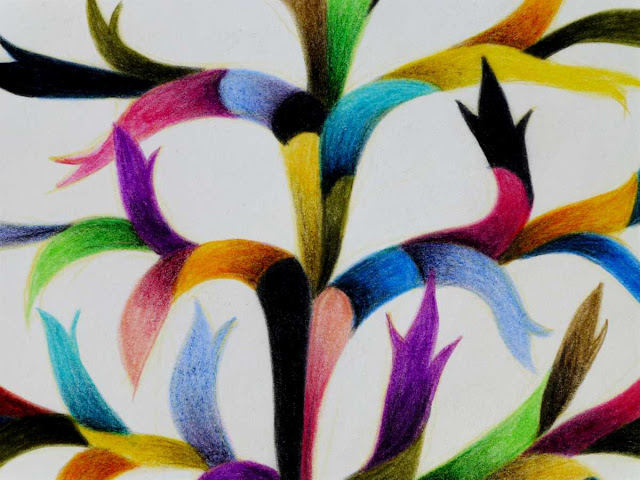Eryngium campestre leaf, painted Otomi style.
Color pencils on paper 21x30cm.
We have become accustomed to the idea that, in modern-day society, the appreciation of beauty in nature is but a luxury for the romantic, lest it produces no money, nor is it good for food or medicine. It sounds right, as a principle, that one should begin evaluating things starting from their immediate benefits, and gradually recognizing the more subtle properties and meaning. Picking mushrooms can serve as a good example. Initially all mushrooms are perceived as poisonous and dangerous, and only the alluring taste of a few much sought-after species is what can make us overcome our fears, and enter their territory. In the process of distinguishing the edible from the toxic, one learns to meticulously observe even the tiniest of details, thus building a relationship with every species.
When we look at something intentionally we add value to it, and the value we perceive becomes our motive to engage in a new adventure.
The development of the souls’ ability to marvel at things is directly associated to her ability for joy and pleasure. Marveling is the feeling of gratitude that springs from the heart whenever we connect to the miraculously unfamiliar sense of life; looking at things always anew, and resisting the idea that “we have seen” or that “we know”. Because we simply don't. This re-evaluation of our senses is part of our awakening to a living, rather than intellectual, world.
What else could it mean that "the sun is new each day" (Heraclitus, fr 6)?
Therefore, insignificant things can obtain new meaning and value, like the leaves of the thistle Eryngium campestre that accompany us in the countryside, or the leaves of Cyclamen hederifolium which bear fractal-like patterns (never-ending geometric patterns) that closely resemble the Mandelbrot set, and pointing to our life in an infinite, multidimensional world. The same sense of timelessness arises when noticing the ancient designs of the red bug Pyrrhocoris apterus, or the fact that the majority of mollusks have shells that spiral clockwise - which was not always the case, flipping from one direction to the other through the eras, as the fossil records reveal.
_____________________________________________________________________
Είμαστε συνηθισμένοι να θεωρούμε πως στον σύγχρονο κόσμο η αποτίμηση της ομορφιάς της φύσης δεν μπορεί παρά να είναι μια πολυτέλεια για ρομαντικούς, εφόσον δεν παράγει χρήματα, δεν τρώγεται, ή δεν «θεραπεύει». Σαν αρχή φαίνεται σωστή και λογική, να ξεκινάει κανείς από τα άμεσα οφέλη για να φτάσει αργότερα σε πιο λεπτοφυείς αξιολογήσεις και αναγνωρίσεις, και η συλλογή μανιταριών αποτελεί ένα καλό παράδειγμα. Αρχικά μοιάζουν όλα να είναι δηλητηριώδη και επικίνδυνα, και μόνο η σαγήνη της γεύσης κάποιων περιζήτητων ειδών είναι αυτή που μας κάνει να ξεπερνάμε τους φόβους μας και να εξοικειωνόμαστε μαζί τους. Στην διαδικασία διάκρισης των εδώδιμων από τα επικίνδυνα μανιτάρια μαθαίνει κανείς να παρατηρεί ακόμη και τις απειροελάχιστες διαφορές μεταξύ τους. Αποκτάει έτσι, σταδιακά, μια ιδιαίτερη σχέση με όλα τα είδη, που μόνο η επιμελημένη παρατήρηση και προσοχή μπορεί να φέρει.
Αξία προστίθεται πάντα στα πράγματα όπου στρέφουμε συνειδητά το βλέμμα μας, και η αξία που τους δίνουμε γίνεται το κίνητρο για την περιπλάνησή μας σε κάθε περιπέτεια.
Η ανάπτυξη της ικανότητας της ψυχής να θαυμάζει, συνδέεται άμεσα με την ικανότητά της να χαίρεται και να αντλεί ευχαρίστηση. Θαυμασμός είναι το αίσθημα ευγνωμοσύνης που αναδύεται στη ανοίκεια συναίσθηση βίωσης του θαύματος. Αυτή η αναγνώριση του κόσμου ως πρωτοειδωμένου, προϋποθέτει μια πάντα φρέσκια ματιά, και την αντίστασή μας στην ιδέα πως «ξέρουμε» ή πως «το έχουμε δει». Θέλει να θυμάται κανείς πως όλα υπάρχουν, κάθε στιγμή, για πρώτη φορά.
Τι άλλο μπορεί να σημαίνει η φράση του Ηράκλειτου "ο ήλιος είναι νέος κάθε μέρα" (απ. 6);
Πράγματα τετριμμένα μπορεί να αποκτούν έτσι νέο νόημα και αξία, όπως τα φύλλα του συνηθισμένου αγκαθιού, και συνοδοιπόρου στην ύπαιθρο, Eryngium campestre, ή εκείνα του κυκλάμινου (Cyclamen hederifolium) που φέρουν σχέδια που θυμίζουν έντονα την γεωμετρική απεικόνιση ενός φράκταλ (ένα απείρως περίπλοκου γεωμετρικού μοτίβου) του Μάντελμπροτ, αφυπνίζοντας έτσι την συναίσθηση πως κατοικούμε σ’ έναν πολυδιάστατο κόσμο. Το ίδιο και τα αρχαιοπρεπή σχέδια του κοινού εντόμου Pyrrhocoris apterus, ή η παρατήρηση πως η πλειοψηφία των σαλιγκαριών (γαστερόποδων), στη στεριά και στη θάλασσα, έχουν κέλυφος που αναπτύσσεται δεξιόστροφα - γεγονός που δεν ίσχυε πάντα σε παρελθούσες γεωλογικές περιόδους, και η ιστορία των απολιθωμάτων μας δείχνει πως η φορά ήταν κάτι που περιοδικά εναλλασσόταν.
Eryngium campestre leaf.
Watercolor, color pencils and gold brush on paper 30x42cm.
Eryngium campestre leaf "dragon shadow".
Watercolor and color pencils on paper 21x30cm.
Geometric fractal-like patterns on Cyclamen hederifolium, resembling the Mandelbrot set.
Geometrical patterns on Pyrrhocoris apterus (very similar to Scantius aegyptius).
The great majority of mollusks today have shells that spiral clockwise.












No comments:
Post a Comment